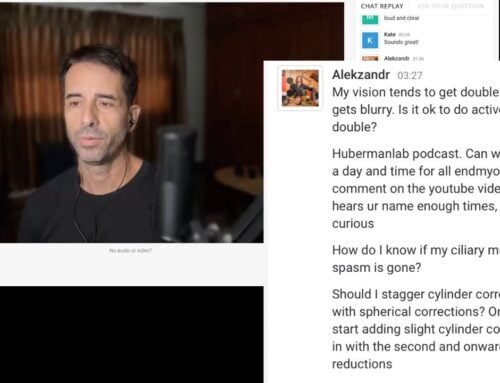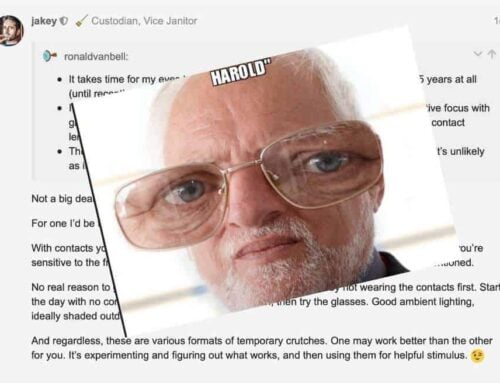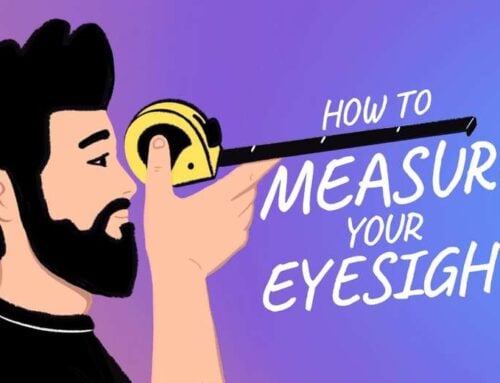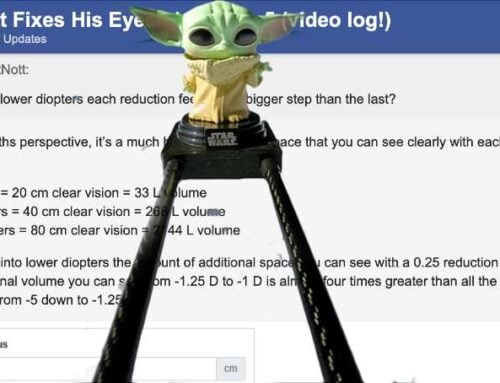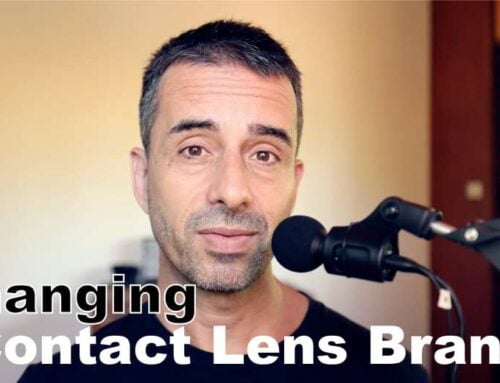This Q&A, applicable if you have spherical correction at or below cylinder correction (high cyl to spherical ratio).
A repost here from two BackTo20/20 support forum threads. While I only provide case specific support in the forum, you might be able to come to your own relevant conclusions based on reviewing these scenarios.
Not sure if my mesurments are very accurate. Having a hard time telling where the actual blur starts. Think this is the astigmatism. For example this morning, left eye varied from 30 to 26.5 and right from 27.3 to 33. When I focus(not sqinting) and blink my eyes can resolve things better than at first glance, sometimes in a more double image, but cannot hold this steady. Similarly with the the Snellen, everything has some blur, but I can make out the letters L and R to 20/63, both eyes 20/50′ though nothing is crystal clear sharp.
A bit of bacground: I have been working at my eysight and seeking to improve my vision for many years now (Huxley, Bates, Kaplan a big part of my search)but only have gotten so far working on my own. Everything you have written and I have read I agree with and know that you know about eyes!
I do not know my previous prescriptions except from 2004 on. This is when I had left -2.50 -3.25/180, right -2.25 -3.00/002for 20/20, but I also got a reading/ computer prescription of -1.75 and -1.50 for the spherical and just wore those all the time so that my next prescription in 09 was down to about those spherical diopters, then I did not make much progress, staying about the same until I took it upon myself to order online where I reduced my spheres by 0.5 diopters and astigmatism by 1/3. I have been wearing only these for about a month now, but really do not have good distance vision and do not seem to be adjusting (quickly, anyways). From what I have been reading on this site, I should probably not have done such a drastic reduction, so staring today I went back to my 20/20 lens which is L -1.75 -3.25/178, R -1.00 -3.25/178. I also have a pair of reading glasses which adds +.75 sphere to each eye.
I would really like to start reducing the asgimatism, as I think this is my biggest problem. Thank you for helping.
My comments:
The cylinder to spherical ratio is indeed very high and needs to be a priority. Mainly since you’re otherwise quite close to being able to do quite well without any glasses at all! As you already recognized, the best thing is to go back to clear vision, get lens correction first to give you exactly what you need.
I sometimes compare our approach to braces for teeth. The starting point needs to be reality, where things are. From there, small corrections towards our desired ideal scenario. Makes for happy biology, getting the right amount of stimulus without undue strain.
Maximum reduction for cylinder in close-up situations (start there since astigmatism is less apparent in close-up) is 1 diopter. A more conservative drop would be half diopter (which is about equivalent of 0.25 diopters spherical). It’s more challenging for your visual cortex to adapt to cylinder correction changes so it’s a good idea to get active focus first (which you probably already have), and good habits both for close-up and distance (ie. getting at least an hour, ideally more of outdoor time with some active focus daily). Once the whole system is accustomed to the habits and regular active focus, you can start pushing the cylinder lower. Be generous with the spherical at the same time (ie. not reducing both at the same time) so that your eyes and brain only have to work on one focal plane change at a time.
Lots of relevant bits for any high cyl to spherical ratio, here. full thread
As always, the theme is reducing diopter complexity. Untangle the artificial focal planes, all while realizing that it’s very important to balance stimulus to be effective without becoming unduly strenuous.
A second post in the support forum, also from today, with more relevant bits on this topic:
Here’s a history of my two differential prescriptions. I have been wearing the second one for about three months now for close-up work. Oddly enough, the first one I now wear for distance vision. In other words, I have not had to go back to my original strong prescription at all.
My 1st differential script (started wearing April 3, 2017 ~ for close-up for about 1 month, now I wear them for distance):
Sphere Cylinder Axis
Right (OD) -1.00 -1.25 006
Left (OS) -0.75 -2.00 002My 2nd differential script (started wearing May 4, 2017 ~ currently still wearing for close-up and mid-range vision):
Sphere Cylinder Axis
Right (OD) -1.00 -0.75 006
Left (OS) -0.75 -1.50 002I have been working on the habits most days (I am better at some than others). I am trying to keep at just the edge of blur when I’m working at my computer. I seem to be able to clear text fairly easily (especially in the mornings, although I do find myself hunching forward toward the screens at the end of the work day – bad! I know.) when I’m working, and it seems just like regular blur. But when I remove my glasses (both for close-up and far distance, and if I look at my Snellen in the distance with my close-up glasses on) there is still the astigmatism blur, although I think it has slightly improved. I would like to reduce my close-up script again to be sure that there’s still some challenge for my eyes to clear while I’m working. I am not yet able to work without my glasses (I sit about 65 to 70 cms from my screens).
So, my question is, which one (spheres or cylinders) to reduce and by how much? And should I be equalizing? I have read some blog articles about trying to equalize scripts by reducing one eye more than the other and there are some discussions about patching. These seem like advanced-degree topics, so I don’t want to mess around without fully understanding them! Again, I defer to your expertise about this next prescription reduction for close-up vision.
Nice detail, being able to use the last differential as new normalized. full thread
My comments:
Generally speaking it’s a good idea to have at least one spherical reduction between cylinder reductions. Much easier for the biology to adapt to spherical than axis specific correction and a nice interim step for gradual improvement.
But then with your cyl to spherical ratio we might need some of that spherical correction to give us enough clarity to make it easier to adapt to cylinder reduction. This is the slightly trick bit!
So the question, a bit subjective here, is whether it seems that the astigmatic blur has reduced. Did you have any before when you started with the current differential, that might now be gone? Looking for change there is good practice, you want to make sure that the eye has been responding to the focal plane change (a good indication that it will continue to do so).
I’d say most likely a 0.25 cylinder reduction is a safe bet, especially since you’re not quite getting enough clarity yet towards the end of the day – we don’t want to ignore this (important) detail.
Make sense?
It all becomes quite obvious once you fully understand the underlying theme. Artificial focal planes are crutches. If you get too much focal plane correction, your eyes will continue to adapt and continue to require more of it (a very profitable proposition for our darlings in the mainstream). Conversely if you substitute focus challenge for over correction, your eyes will respond accordingly with a lesser need for artificial focal planes.
Orthodontists figured out the concept with braces for teeth. Then again there’s money in that, and underlying causality with why your teeth are misaligned is still ignored – but baby steps, the teeth guys are quite far ahead of the eye guys.
Until that vacuum of knowledge becomes filled elsewhere, you get to DIY your eyeballs. You and your most darling, most of the last of the eye gurus.
Cheers,
-Jake




